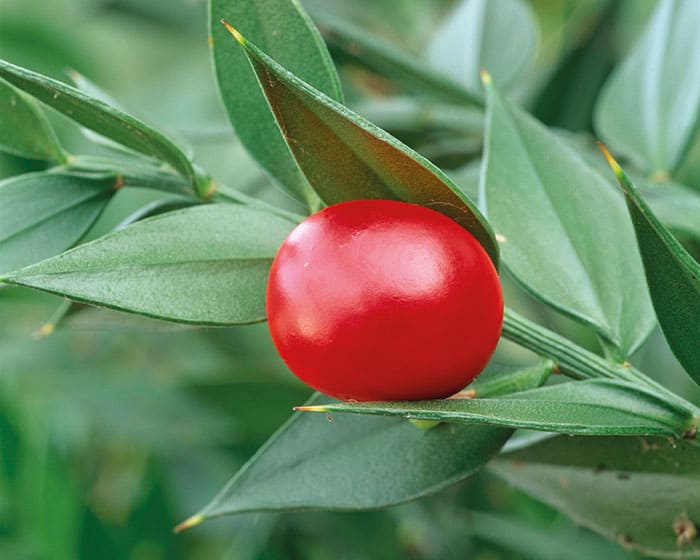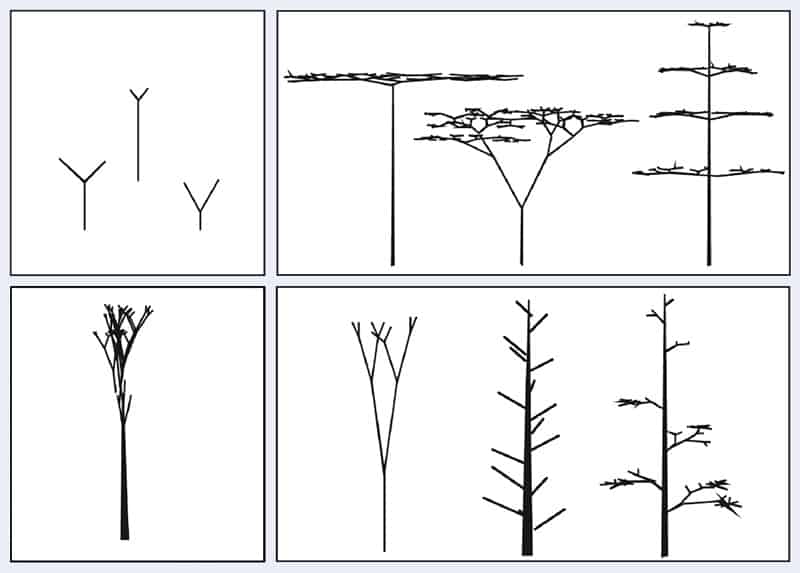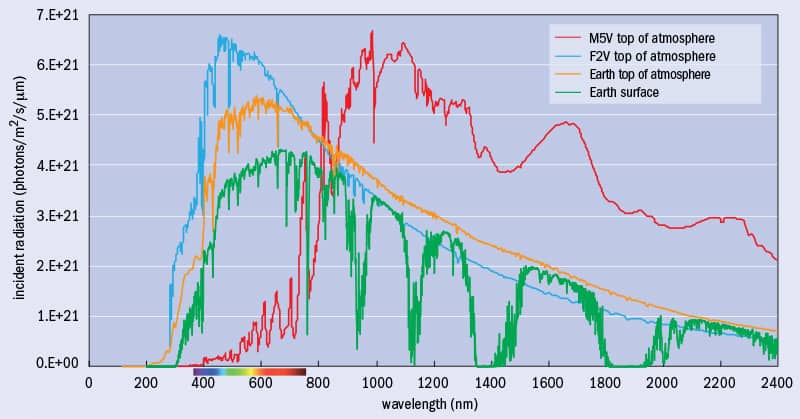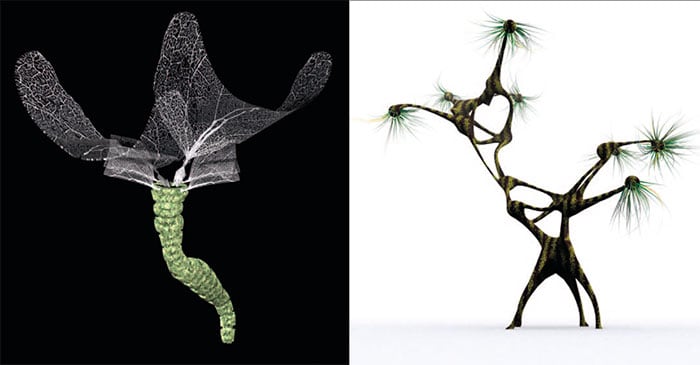As the number of confirmed extrasolar planets increases, so does the likelihood that some of them will harbour life. Lewis Dartnell describes some preliminary – but increasingly well founded – efforts to predict what alien plants and animals might look like
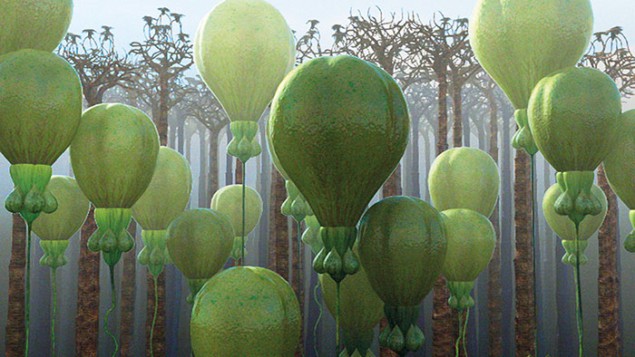
In December 2011 the Kepler Space Telescope spotted a staggeringly exciting object. Kepler is a planet hunter and, since its launch in March 2009, it has been staring intently along the spiral arm of our Milky Way galaxy, looking for telltale winks of starlight. Each wink is potentially the result of a planetary companion of a distant sun passing between its parent star and Kepler’s sensitive light-gathering instruments. So far, Kepler has detected more than 2300 planetary candidates using this “transit” method; many of these are large worlds on close, hot orbits around their star. But on 5 December last year the Kepler science team announced the discovery of a very special kind of world: a roughly Earth-sized planet orbiting within the so-called habitable zone of its Sun-like star. This planet, Kepler-22b, is just over twice the radius of our home world, making it a smallish “super-Earth” in planetary terms. Its presence in the habitable zone means it could contain liquid water on its surface: warm seas and oceans, the perfect cradle for life.
The discovery of Kepler-22b stands out as a high point in the short history of astrobiology, the field of science concerned with the possibility of life beyond our Earth. This young discipline is blossoming thanks not just to Kepler, but also to the extensive evidence for a watery era on ancient Mars and Earthbound discoveries of “extremophile” life in incredibly hostile niches. With the Kepler data suggesting that there are more planets than stars in our galaxy, and that around 2% of Sun-like stars are expected to host Earth-like planets in their habitable zones, it seems likely that other life-bearing worlds exist. On some of these, it is possible that evolution has progressed beyond primitive micro-organisms to yield multicellular lifeforms: analogues of terrestrial animals and plants. The question is, what might these alien species look like?
Common ground
Hollywood films often give the impression that aliens will be curiously humanoid, resembling actors with bits of plasticine stuck to their foreheads or dressed up in gorilla suits. This trend is, of course, born out of convenience for the props department more than any scientific rationale, but there are good reasons to expect that some aspects of our biology may indeed be present in extraterrestrial life. We can actually be pretty confident that complex alien life forms, both plant and animal, on an Earth-like world will be broadly recognizable, and will share many features with their terrestrial analogues.
One reason for this similarity is that certain adaptations, such as eyes and wings, are so useful that evolution on Earth has hit upon them independently more than once. For example, avian, insect and mammalian species have all separately evolved powered flight, while the “camera lens” eye designs of vertebrates and cephalopods such as the octopus or squid are astoundingly similar (and, in some respects, superior to our own). The process of biological adaptation strives to find solutions to particular survival problems – a plant may need to collect sunlight more efficiently than its neighbours, for example, or a fish might not survive unless it can out-swim its predators – and the diversity of life on Earth is a testament to its inventiveness. However, there are some survival problems that may in fact only have a few good solutions. The result is that a similar design emerges time and time again, a phenomenon known as “convergent evolution” (see photo below). In addition to eyes and wings, a number of other attributes of terrestrial organisms have also arisen independently multiple times through convergence. As the biologist Jack Cohen so delightfully phrased it, “The four universal F’s of evolution are fur, photosynthesis, flight and…mating!”
There are also physics-based reasons for thinking that alien life will resemble that found on Earth. Life developing on worlds throughout the universe will be subject to exactly the same scientific laws and principles of good engineering as we are here on Earth. You would expect alien fish, for example, to have developed a streamlined shape and fins or a tail for propulsion. In fact, they may end up looking uncannily like salmon.
As for the plant life in the forests and jungles of an alien Earth, it may prove to be equally recognizable, given the same mix of biological and physical factors. The most immediately obvious feature of a land plant or tree is its overall shape (seen most easily on Earth in deciduous trees that have shed their leaves in autumn), and we have some reason to believe that alien plants will have similar shapes. As plant biologist Karl Niklas of Cornell University in the US explains, any land plant has to simultaneously satisfy four basic requirements for survival: it must maximize the amount of light it intercepts for photosynthesis; disperse its pollen or seeds as far as possible; ensure it does not grow unstable and topple over; and prevent itself from losing too much water through exposed surfaces such as leaves.
These four principles are sometimes in conflict with each other. For example, to optimize light collection, a plant might evolve into a shape featuring lots of leaves in a very wide flat canopy, like a parasol. However, this would make it vulnerable to uprooting in high winds. Evolution will attempt to find the optimum compromise between the four fundamental requirements, and so the fittest design for a plant depends on the prevailing conditions in its own local environment. Often, one of the requirements will outweigh the others. A plant growing in the extremely desiccating and sunlight-rich environment of a desert, for example, will end up looking very different from a tree with sufficient access to water but located at high latitudes where the Sun is forever low in the sky.
Black and blue
Niklas has been studying the interplay of these factors in the evolution of plant design by running computer models of the evolutionary process. When the parameters in his models are weighted towards one or more different requirements, the tree designs produced by Niklas’ artificial evolution are start-lingly similar to the species of tree and plant found in different environments on Earth (figure 1). Astrobiologists expect this likeness to also hold true for complex photosynthetic organisms evolving on other planets. A plant adapted to desert conditions on any world would need to be squat and unbranched, like a cactus, minimizing surface area and so limiting water loss. A tree that needed maximum stability would be structured much like a fir, and a tree growing in moist temperate soils would have large photosynthetic surfaces and a broad crown like an oak.
The shapes of trees in alien forests are likely to be pretty similar to earthly varieties, as long as they are growing in comparable environments. But what about other attributes, such as the colours of their leaves? On Earth, plants and trees look green because the pigment that drives photosynthesis, chlorophyll, absorbs blue light (which is most energetic) and red light (which is most plentiful) much more strongly than green light. But although plants reflect green light, their reflectance spectrum actually shows a much more intense feature at wavelengths just longer than the visible range – a feature known as the “red edge”. Indeed, if our eyes were sensitive to a slightly wider range of light wavelengths, plants would appear not a verdant green, but a lush near-infrared colour.
Terrestrial plants probably reflect these near-infrared wavelengths to avoid overheating in the Sun. More generally, on any planet, the most important factors influencing the complement of pigments used for photosynthesis will be the radiation spectrum of the alien sun and how this light is transmitted through the planet’s atmosphere (figure 2). Plants growing by the light of another sun will be spectrally tuned to make optimal use of this light, preferentially absorbing either the most common wavelengths of photons or those carrying the most energy. This will be true even if the plant’s homeworld is orbiting a star of a different colour, or spectral type, to our Sun. As Nancy Kiang of the NASA Goddard Institute for Space Studies points out, forests growing by the light of a star bluer or redder than our Sun would need photo-synthetic pigments tuned to this shifted spectrum.
Our Sun is a G2 star and the peak of its emission spectrum, the sunlight beaming upon the Earth, lies at around 550 nm. F-class stars, however, burn hotter and brighter than our Sun, and their spectrum is shifted towards blue. Surprisingly, though, this might not make a tremendous difference to the colour of plants on planets orbiting F-class stars, relative to terrestrial plants. Kiang explains that this is because F-class stars’ emission spectra still contain a lot of visible light, even though the overall spectrum is shifted to shorter wavelengths. Alien plants growing in such an environment might, however, face a problem with the intense flood of energetic blue light and so might need to develop protection mechanisms and reflect more of this blue light away. In other words, vegetation on a world orbiting an F-star might look blue to our eyes, but still have the distinctive red edge in its reflectance spectrum that goes with oxygen-producing photosynthesis.
The situation would be different for M-class dwarf stars, which are smaller and cooler than our Sun, and gleam with a fainter, redder light. Plants growing on a planet orbiting such a “red dwarf” star would need to absorb as much of this sunlight as possible to gather the energy to grow, and would probably therefore appear black to our eyes. (Of course, the eyes of any animals that evolved on the planet would also have been tuned to the cooler spectrum, and so they would see their plants as an intense infrared colour.) Plants in such black forests might also adapt to a long-wavelength, low-energy photon environment by developing photosynthetic systems capable of collecting several photons at a time, in order to harvest enough energy to crack water and liberate oxygen. One further complication is that many M-class red-dwarf stars appear to be quite active, with regular intense solar flares, so plants on any orbiting worlds may find aquatic habitats more conducive to life. Under water, plants would be shielded from the spasmodic floods of ultraviolet radiation triggered by flares, but still receive enough light for growth.
Really alien plants
Instead of striving up towards the sun like a towering column, why should these plants not simply float in the air?
So far, we have assumed that plants growing under Earth-like conditions on other planets will find similar solutions to survival problems. But what if alien evolution develops completely novel adaptations? Are there other ways of satisfying the four survival constraints that do not exist in terrestrial biology?
Consider a super-Earth planet more massive than our own, such as the recently discovered Kepler-22b or even heavier planets discovered earlier. On such a world, the increased pull of gravity would stunt the growth of even the stoutest-trunked tree. Perhaps evolution playing out on such a world would stumble across a strikingly different answer to this survival challenge. Instead of striving up towards the sun like a towering column, why should these plants not simply float in the air?
All plants, algae and cyanobacteria on Earth grow by harvesting the energy of sunlight to crack apart molecules of water, a process called oxygenic photosynthesis. The hydrogen liberated in this process is used to reduce carbon dioxide and so produce carbohydrate food. The oxygen is simply released as waste gas. An alien plant, however, could instead release some of its hydrogen into an inflatable membrane and so float skyward, anchored to the ground with a vine-like tether. These “zeppelin plants” could also employ a very simple reproduction strategy, perhaps evolving some mechanism of detaching from their tethers to fly away on the winds and scatter seeds or spores across the terrain below.
There seems to be nothing in physics that would forbid such an organism from developing. Indeed, an analogous strategy is found in Earth’s oceans, where forests of kelp keep themselves buoyant in the sunlit surface waters of terrestrial seas by pumping carbon dioxide or oxygen into small flotation bladders. Perhaps the only reason that zeppelin plants have not emerged on Earth is that the environmental conditions do not favour such an adaptation, since the terrestrial gravity is not strong enough to discourage alternative solutions.
Plant life on a super-Earth would also face a challenge in hauling water from the roots up to the tallest leaves. The maximum height that water can be drawn up by capillary action is determined by the balance between the surface tension of water and the gravitational strength. On Earth, the theoretical maximum is just over 100 m high, and this is indeed the limit reached by the tallest trees on the planet. On a super-Earth, trees may not be able to rely on such a passive mechanism, so they might develop active systems for pumping water to their canopies. Alternatively, they might find a new solution altogether, such as evolving trumpet-like adaptations of their top leaves to collect rain and so distribute water down through their vascular transport system. So on a super-Earth, with different environmental challenges, you may well expect evolution to play out in surprising new directions.
Detecting life
Much of this article has been, in essence, a “thought experiment” on how biology might have responded to the laws of physics and engineering principles on another world. Soon, though, such speculative attempts to predict the form of extraterrestrial life will take on a new and crucial importance. Kepler and other exoplanet-hunting programmes are ca-pable of detecting a true twin of our homeworld in the next few years. The next step will be to characterize each of the planets on this “shopping list” of nearby Earth-like worlds by performing spectroscopy on the light isolated from the planet itself, excluding that from its parent star.
These measurements should make it possible for us to detect telltale signs of life, or biosignatures, on alien planets. An oxygen-rich atmosphere would, of course, be a very exciting biosignature, but it may also be possible to detect spectral features of alien vegetation, akin to the red edge of terrestrial plants. We have already learned, for example, that plant life on a planet orbiting a red-dwarf star might produce a big spectral feature at slightly longer wavelengths. Intriguingly, Giovanna Tinetti, an astrophysicist at University College London, has suggested that such a feature might be easier for our telescopes to detect than the red edge of terrestrial vegetation, since longer wavelengths of light are less likely to be obstructed by a planet’s clouds. The key step, as we have seen, lies in trying to calculate the wavelengths at which these spectral biosignatures might appear. Astrobiologists are currently grappling with such considerations as they research how to detect photosynthesis and other signs of advanced life in the spectra of alien Earth-like worlds.
